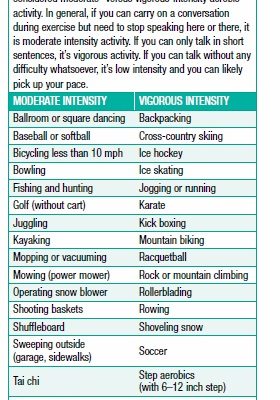11. Healthy Lifestyle
As important as it is to eat well, as discussed in the bulk of this report, other lifestyle factors, including exercise and sleep, also impact your health. Compared with less active people, those who are more physically active tend to live longer and have lower risks of many chronic diseases, such as heart disease, high blood pressure, stroke, type 2 diabetes, some cancers, and depression. Physical activity also helps slow down the muscle loss and cognitive decline that comes with age. As for getting your ZZZ’s, studies suggest adequate sleep may support heart health, among other benefits.
Guidelines for Physical Activity
The Physical Activity Guidelines for Americans, established in 2008, advise that adults, to the best of their ability:
- Engage in at least 150 minutes of moderate-intensity aerobic activity, such as brisk walking, every week, or engage in at least 75 minutes of vigorous-intensity activity, such as jogging, each week (see Box 11-1, “Determining Exercise Intensity”). To reach this 150-minute minimum, you might exercise for 30 minutes five days a week, or you can break this down into shorter exercise sessions, if needed. It’s best to do aerobic exercise in at least 10-minute increments spread throughout the week. If you’re able to exercise more than 150 minutes per week, then do so. More physical activity generally offers even greater benefits.
- Participate in muscle-strengthening activities that work all major muscle groups at least twice weekly. Examples include lifting free weights, using weight machines, or working with resistance bands.
Unfortunately, a national study of physical activity in the U.S. suggests that less than 5 percent of adults get at least 30 minutes of moderate-intensity exercise on most days of the week. This shortfall in physical exercise tends to worsen the older we get.
Sit Less
Beyond lack of formal exercise, people also have become very sedentary—spending too much time sitting while watching TV, working on the computer, using smartphones, and so on. Being too sedentary, in and of itself, has been linked with increased risks of obesity and chronic diseases, such as heart disease and type 2 diabetes.
In addition to working exercise into your daily routine, find ways to reduce the amount of time you spend sitting, and intersperse short periods of walking into sedentary activities. For example, stand up and take a break from your book after every chapter, or get up and move around for a few minutes during TV commercials. In a preliminary observational study of 3,626 relatively sedentary adults, including a subgroup of 383 people with chronic kidney disease, casually walking (light activity) for as little as two minutes per hour, instead of sitting, was associated with a 33 percent lower risk of mortality (premature death) overall, and a 41 percent lower mortality risk in those with kidney disease.
Meeting Physical Activity Goals
If you’ve been inactive for a while, are dealing with disease or disability, or have never had a formal exercise program, don’t let the physical activity guidelines overwhelm you. Just do what you can and slowly build up as you’re able. If you’re in good health and your doctor has encouraged you to exercise, you can begin exercising now. If you’re experiencing a health-related symptom that has not previously been evaluated by your doctor, consult your healthcare provider first. Having a health condition such as arthritis, heart disease, or diabetes doesn’t mean you can’t be active. Talk to your healthcare provider to learn the best way to approach increasing your physical activity.
The Value of a Good Night’s Sleep
The average person needs 7 to 8 hours of sleep per night. Studies have shown that adequate sleep contributes to healthier blood pressure, cholesterol, and triglyceride levels, whereas falling short on sleep increases the risk of weight gain and depression. In a large observational study, scientists found that averaging more than seven hours of sleep a night was associated with a 22 percent lower risk of cardiovascular disease and 43 percent lower risk of dying of cardiovascular causes, regardless of other lifestyle factors. These benefits were amplified when people also ate healthfully, exercised, limited alcohol intake, and avoided smoking. For ideas to improve your sleep, see Box 11-2, “Tips for Better Sleep.”
The post 11. Healthy Lifestyle appeared first on University Health News.
Read Original Article: 11. Healthy Lifestyle »
Powered by WPeMatico




